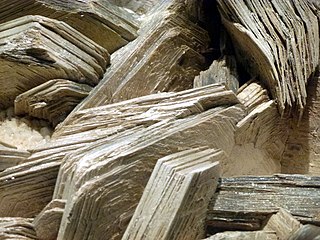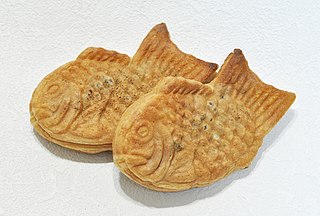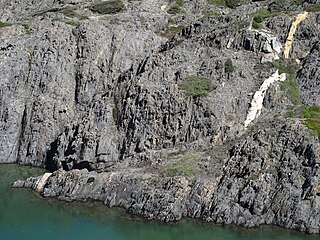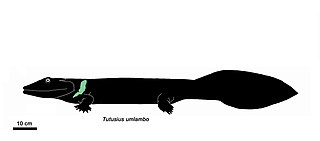
Micas are a group of silicate minerals whose outstanding physical characteristic is that individual mica crystals can easily be split into extremely thin elastic plates. This characteristic is described as perfect basal cleavage. Mica is common in igneous and metamorphic rock and is occasionally found as small flakes in sedimentary rock. It is particularly prominent in many granites, pegmatites, and schists, and "books" of mica several feet across have been found in some pegmatites.

Metamorphic rocks arise from the transformation of existing rock to new types of rock in a process called metamorphism. The original rock (protolith) is subjected to temperatures greater than 150 to 200 °C and, often, elevated pressure of 100 megapascals (1,000 bar) or more, causing profound physical or chemical changes. During this process, the rock remains mostly in the solid state, but gradually recrystallizes to a new texture or mineral composition. The protolith may be an igneous, sedimentary, or existing metamorphic rock.

Taiyaki is a Japanese fish-shaped cake, commonly sold as street food. It imitates the shape of tai, which it is named after. The most common filling is red bean paste that is made from sweetened adzuki beans. Other common fillings may be custard, chocolate, cheese, or sweet potato. Some shops even sell taiyaki with okonomiyaki, gyoza filling, or a sausage inside. Smaller, differently shaped versions called kingyoyaki are also available and often sold in bags of five, ten, or more.

In geology, a shear zone is a thin zone within the Earth's crust or upper mantle that has been strongly deformed, due to the walls of rock on either side of the zone slipping past each other. In the upper crust, where rock is brittle, the shear zone takes the form of a fracture called a fault. In the lower crust and mantle, the extreme conditions of pressure and temperature make the rock ductile. That is, the rock is capable of slowly deforming without fracture, like hot metal being worked by a blacksmith. Here the shear zone is a wider zone, in which the ductile rock has slowly flowed to accommodate the relative motion of the rock walls on either side.
Lake Revelstoke or Revelstoke Lake or Revelstoke Lake Reservoir is an artificial lake on the Columbia River, north of the town of Revelstoke, British Columbia and south of Mica Creek. This lake is the reservoir formed by the Revelstoke Dam, which during its construction was also known as the Revelstoke Canyon Dam, inundating the Columbia's canyon in this area and the historic Dalles des Morts and some of the former gold diggings of the Big Bend Gold Rush. The dam's site is at what had been the head of river navigation by steamboat from Northport, Washington via the Arrow Lakes.

Swedish Fish is a fish-shaped, chewy candy originally developed by Swedish candy producer Malaco in the late 1950s for the U.S. market. They come in a variety of colors and flavors.

Mylonite is a fine-grained, compact metamorphic rock produced by dynamic recrystallization of the constituent minerals resulting in a reduction of the grain size of the rock. Mylonites can have many different mineralogical compositions; it is a classification based on the textural appearance of the rock.

In geology, shear is the response of a rock to deformation usually by compressive stress and forms particular textures. Shear can be homogeneous or non-homogeneous, and may be pure shear or simple shear. Study of geological shear is related to the study of structural geology, rock microstructure or rock texture and fault mechanics.

In optical mineralogy and petrography, a thin section is a thin slice of a rock or mineral sample, prepared in a laboratory, for use with a polarizing petrographic microscope, electron microscope and electron microprobe. A thin sliver of rock is cut from the sample with a diamond saw and ground optically flat. It is then mounted on a glass slide and then ground smooth using progressively finer abrasive grit until the sample is only 30 μm thick. The method uses the Michel-Lévy interference colour chart to determine thickness, typically using quartz as the thickness gauge because it is one of the most abundant minerals.
Fluorosilicate glass (FSG) is a glass material composed primarily of fluorine, silicon and oxygen. It has a number of uses in industry and manufacturing, especially in semiconductor fabrication where it forms an insulating dielectric. The related fluorosilicate glass-ceramics have good mechanical and chemical properties.

In geology, texture or rock microstructure refers to the relationship between the materials of which a rock is composed. The broadest textural classes are crystalline, fragmental, aphanitic, and glassy. The geometric aspects and relations amongst the component particles or crystals are referred to as the crystallographic texture or preferred orientation. Textures can be quantified in many ways. The most common parameter is the crystal size distribution. This creates the physical appearance or character of a rock, such as grain size, shape, arrangement, and other properties, at both the visible and microscopic scale.

Acorn Park is a 0.1247-acre (500-square-metre) urban park in downtown Silver Spring, Maryland, which features an acorn-shaped gazebo and an artificial grotto. The site is historically significant as it is thought to be the location of the "mica-flecked spring" that in 1840 inspired Francis Preston Blair to name his estate "Silver Spring".

Oakley stone is the trade name of a building stone that occurs in the mountains of southern Idaho in the western United States. It is more properly known as Rocky Mountain quartzite or Idaho quartzite, a metamorphic rock. The stone is quarried south of the city of Oakley in Cassia County, northeast of the three-state border with Nevada and Utah. The quarries are located on the west slope of Middle Mountain in the Albion Mountains, northwest of the City of Rocks National Reserve.

Skolithos is a common trace fossil ichnogenus that is, or was originally, an approximately vertical cylindrical burrow. It is produced by a variety of organisms in shallow marine environments globally and appear as lineated features in sedimentary rocks.
In geology oblique foliation, steady state foliation or oblique fabric is a special type of a tectonically produced foliation or fabric, most commonly in quartz-rich layers. The microtectonic structure can be used to determine the shear sense in shear zones and their associated rocks, usually mylonites.

The Balta Mică a Brăilei Natural Park is a protected area which is situated in Romania, in Brăila County, on the administrative territory of communes Berteștii de Jos, Chiscani, Gropeni, Mărașu and Stăncuța.
The Burlington mylonite zone is a 1.5 kilometer thick mylonite zone, resulting from the dynamic recrystallization and grain size reduction of rocks, running from Weston, Massachusetts to Lynnfield, Massachusetts and Danvers, Massachusetts. The deformation that formed the zone is believed to be related to the Bloody Bluff Fault. In 1976, R. O. Castle released information indicating that the Paleozoic Early Devonian Peabody Granite intruded the mylonite zone, giving a young age limit for the formation.
The Middleton Basin is a small sedimentary basin, in northeastern Massachusetts, containing Late Triassic and Early Jurassic red beds. Estimated to be 5.7 kilometers long and at most half a kilometer wide, it is one of the smallest basins in the state and is closely associated with the Newbury basins.

The geology of Sweden is the regional study of rocks, minerals, tectonics, natural resources and groundwater in the country. The oldest rocks in Sweden date to more than 2.5 billion years ago in the Precambrian. Complex orogeny mountain building events and other tectonic occurrences built up extensive metamorphic crystalline basement rock that often contains valuable metal deposits throughout much of the country. Metamorphism continued into the Paleozoic after the Snowball Earth glaciation as the continent Baltica collided with an island arc and then the continent Laurentia. Sedimentary rocks are most common in southern Sweden with thick sequences from the last 250 million years underlying Malmö and older marine sedimentary rocks forming the surface of Gotland.

Tutusius is a genus of extinct tetrapod from the Devonian of South Africa, containing a single species, Tutusius umlambo. It was described from the +/- 360 myo Gondwana locality of Waterloo Farm lagerstätte on the south-eastern coast of South Africa, which at the time was located within the Antarctic Circle. Together with the find of Umzantsia amazana from the same locality, this provides the first evidence that Devonian tetrapods were not restricted to the tropics as was formerly believed, and suggests that they may have been global in distribution. Waterloo Farm fossils have been metamorphosed and intensely flattened, with the bone tissue replaced by secondary metamorphic mica that is partially altered to kaolinite and chlorite during uplift. They also provide the first evidence of Devonian tetrapods from the continent of Africa, and only the second and third such taxa from Gondwana.















